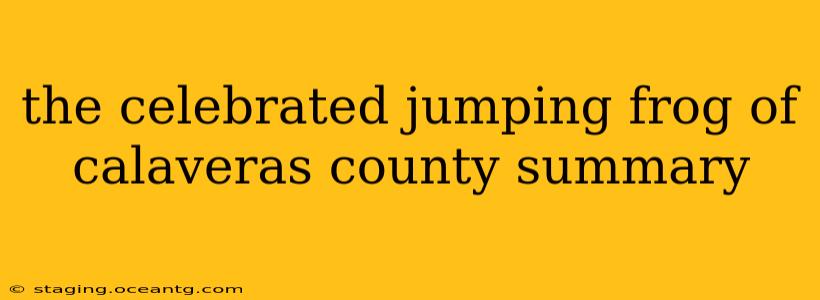Mark Twain's "The Celebrated Jumping Frog of Calaveras County" is a deceptively simple story that packs a powerful punch. While seemingly a humorous anecdote about a jumping frog contest, it's a masterclass in storytelling, exploring themes of deception, naiveté, and the clash between East and West Coast cultures. This summary will delve into the plot, characters, and underlying meaning, answering common questions readers often have.
What is the story about?
The narrative unfolds through a first-person perspective, with the unnamed narrator recounting a tale he heard from Simon Wheeler, a seemingly unassuming storyteller in the gold-mining town of Angel's Camp, California. The narrator's friend, a scholarly gentleman, had asked him to find a man named Leonidas W. Smiley, leading to his unexpected encounter with Wheeler and his rambling, digressive tale. Wheeler's story centers on Jim Smiley, a compulsive gambler who bets on everything, including a remarkably skilled jumping frog named Dan'l Webster. The story recounts Dan'l Webster's various victories, only to reveal that Smiley's unsuspecting nature ultimately leads to his downfall when a stranger secretly fills Dan'l Webster with quail shot, hindering his jumping ability and winning the bet.
What is the significance of the title?
The title itself, "The Celebrated Jumping Frog of Calaveras County," hints at the irony central to the story. "Celebrated" implies fame and renown, yet the frog's fame is limited to the small, isolated community of Calaveras County. This foreshadows the broader theme of local versus broader cultural significance, a key aspect of Twain's commentary on the American West.
What are the main themes?
Several important themes emerge throughout the story:
-
Deception and trickery: The stranger's deception of Jim Smiley forms the core conflict. It underscores the prevalence of deception in the rough-and-tumble world of the California gold rush.
-
Naiveté and gullibility: Jim Smiley's unquestioning faith in his frog's abilities highlights his naiveté and vulnerability to manipulation.
-
East vs. West Coast Culture: The contrast between the sophisticated, educated narrator and the rustic, rambling Simon Wheeler, exemplifies the clash of cultures between the East and West Coasts. The narrator's initial disappointment underscores his preconceived notions of the West, which are ultimately challenged by the story itself.
-
The Power of Storytelling: The story itself is a testament to the power of storytelling, both in its ability to entertain and its capacity to reveal deeper truths about human nature.
What is the significance of the ending?
The ending, where the narrator abruptly concludes his tale, reflects the anti-climactic nature of the entire experience. The narrator, initially expecting a straightforward account of Leonidas W. Smiley, instead receives a long, meandering, and ultimately irrelevant story, highlighting the difference in expectations between the sophisticated East Coast visitor and the eccentric local culture of the West.
Why is the story considered humorous?
The humor comes from several sources:
-
Exaggeration and hyperbole: Twain's use of hyperbole in describing Jim Smiley's gambling habits and Dan'l Webster's jumping prowess creates a comedic effect.
-
Irony and satire: The irony of the stranger's deception and Smiley's unwitting participation adds layers of humor to the narrative.
-
Character portrayal: The eccentric characters, particularly Simon Wheeler, with his rambling style and seemingly endless stream of digressions, contribute significantly to the story's humorous tone.
Is there a moral to the story?
While there isn't a straightforward moral, the story implicitly critiques gullibility, highlights the importance of cultural awareness, and underscores the unpredictable nature of human interaction in a frontier setting.
In conclusion, "The Celebrated Jumping Frog of Calaveras County" is more than just a funny tale about a frog; it's a nuanced exploration of human nature and cultural differences, masterfully delivered with Twain's signature wit and storytelling prowess. Its enduring popularity speaks to its timeless appeal and the universal themes it addresses.
